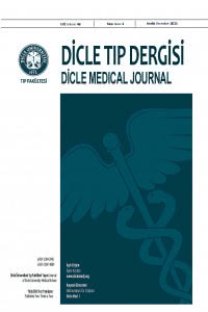Hepatitis B virus is still the most common etiologic factor of liver cirrhosis: Results from a single center in Turkey
Hepatit B virüsü karaciğer sirozunun halen en yaygın etyolojik faktörüdür: Türkiyede tek merkezden sonuçlar
___
- Grant BF, Dawson DA, Stinson FS, et al. The 12-month prevalence and trends in DSM-IV alcohol abuse and dependence: United States, 19911992 and 20012002. Drug Alcohol Depend 2004;74:223234.
- Di Bisceglie AM. Natural history of hepatitis C: its impact on clinical management. Hepatology 2000;31:10141018.
- Merican I, Guan R, Amarapuka D, et al. Chronic hepatitis B virus infection in Asian countries. J Gastroenterol Hepatol 2000;15:13561361.
- Ökten A. Karaciğer sirozu. In: Büyüköztürk K, Atamer T, Dilmener M, eds. İç Hastalıkları cilt-1, 1st edn. Ankara: Nobel Tıp Kitabevi, 2007:1077-1088.
- Michitaka K, Nishiguchi S, Aoyagi Y, et al. Etiology of liver cirrhosis in Japan: a nationwide survey. J Gastroenterol 2010;45:86-94.
- Değirmencioğlu ZA. Hepatit Bye bağlı siroz hastalarında Child Pugh evrelemesine göre HBV DNA düzeylerinin karşılaştırılması. İç hastalıkları ihtisas tezi. İnönü Üniversitesi Tıp Fakültesi, Malatya, 2009.
- Tozun N, Ozdogan OC, Cakaloglu Y, et al. A nationwide prevalence study and risk factors for Hepatitis A, B, C and D infections in Turkey. Turkey Liver Research Association National Hepatitis Often Study (TURKHEP 2010). Hepatology 2010;52:697.
- Ayyıldız MO. Yöremizde karaciğer sirozunda HBV, HCV ve HDVnin rolü. İç Hastalıkları ihtisas tezi Dicle Üniversitesi Tıp Fakültesi, Diyarbakır, 1994.
- Topdagi O, Okcu N, Bilen N. The Frequency of Complications and the Etiology of Disease in Patients with Liver Cirrhosis in Erzurum. The Eurasian Journal of Medicine 2014;46:110-114.
- Farrell GC, Larter CZ. Nonalcoholic fatty liver disease: from steatosis to cirrhosis. Hepatology 2006;43:99-112.
- Demir ME, Aydoğan T, Pamukcu M, et al. Ultrasound evaluation of metabolic syndrome patients with hepatosteatosis J Clin Exp Invest 2013;4:153-158.
- Temizhan A, Korkmaz A. Metabolik Sendrom Tanısı ve Epidemiyolojisi. Turkiye Klinikleri Journal of Endocrinology Special Topics 2011;4:1-6.
- Feld JJ, Heathcote EJ. Epidemiology of autoimmune liver disease. J Gastroenterol Hepatol 2003;18:1118-1128.
- Das SK, Ray K. Wilsons disease: an update. Nature Clinical Practice Neurology 2006;2:482-493.
- Tuğ E, Balaban YH. Wilson Disease: Case Report. Dicle Med J 2007;34:57-60.
- Poynard T, Lebray P, Ingiliz P, et al. Prevalence of liver fibrosis and risk factors in a general population using non-invasive biomarkers (FibroTest) BMC Gastroenterol 2010;10:40-53.
- ISSN: 1300-2945
- Yayın Aralığı: 4
- Başlangıç: 1963
- Yayıncı: Cahfer GÜLOĞLU
Karpal tünel sendromlu hastalarda mini açık yaklaşım sonuçlarımız
Azad YILDIRIM, Ahmet KAPUKAYA, Şehmus YİĞİT, RAMAZAN ATİÇ, Yılmaz MERTSOY, Mehmet Akif ÇAÇAN
Çok ileri yaşlı hastalarda (75 yaş ve üzeri) perkütan nefrolitotomi
Hüseyin ÇELİK, Caner Ediz, Ahmet ÇAMTOSUN, Ramazan ALTINTAŞ, Cemal TAŞDEMİR
Retrospective analysis of 14 patients who managed for adnexal torsion during pregnancy
Mesut Polat, Taylan Şenol, Adnan İncebıyık, Enis Özkaya, İlhan Şanverdi, Evrim Bostancı, Egemen Aydın, Ateş Karateke
Yusuf ÇAKMAK, Mehmet Baki ŞENTÜRK, MEHMET ŞÜKRÜ BUDAK
Mehmet TÜRKEN, SEDAT YILMAZ, Leyla ÇOLPAN, Belkıs AYDINOL*, Alpaslan Kemal TUZCU
Abdullah Çim, Salih Coşkun, Ahmet Yılmaz, Hüseyin Onay
Brusella jel aglütinasyon testinin diğer Brusella testleri ile karşılaştırılması
N. Mine TURHANOĞLU, Demet VURAL
DLT çivisi uygulanan intertrokanterik femur kırıklarının tedavi sonuçları
MEHMET ARICAN, Kadir İlker YILDIZ, Zekerya Okan KARADUMAN, Mehmet Şirin BULUT, Serkan ÖZKAN
HAKAN TEMİZ, Erdal ÖZBEK, Serdar Ferit TOPRAK, Arzu ONUR, Sabahattin ERTUĞRUL
MUAMMER BİLİCİ, İBRAHİM İLKER ÖZ, Sevil İLİKHAN UYGUN, Müzeyyen ARSLANER, Elif KAHRAMAN, Beyza KILAVUZ, Zeynep ÖZDAMAR, ŞEHMUS ERTOP
